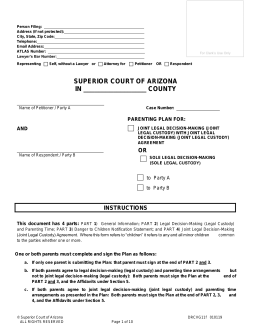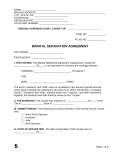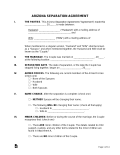Updated January 08, 2024
An Arizona parenting plan is a legal document that outlines how parents will share rights and responsibilities related to their child. Arizona courts prioritize joint decision-making authority, in which parents share the ability to decide on the child’s health, education, and religious influences.
It is important to understand that joint decision-making authority does not necessarily mean equal parenting time. The court’s guiding principle in deciding on these types of matters is what’s best for the child.
Statutory Factors
- The child’s past, present, and potential future relationship with either parent;
- Each parent’s living arrangements;
- The child’s ability to adapt to a location and community;
- The child’s wishes;
- Which parent is likely to allow the other parent contact with the child;
- Each parent’s intentions;
- Whether there were incidents of domestic violence or child abuse;
- Whether either parent filed a false report of child abuse or neglect; and
- Whether a parent coerced the other parent into an agreement.
Source: A.R.S § 25-403
Table of Contents |
How to File in Arizona
1. Agree on a Parenting Plan

While the term “custody” is widely used in many states, Arizona lawmakers have deliberately phased it out[1] in favor two related concepts: legal decision-making authority and parenting time. To address these issues, parents should complete the official Parenting Plan (Form DRCVG11f) covering the following:
- Legal decision-making authority. Decide which parents will make decisions on behalf of their child. This commonly involves decisions regarding:
- Healthcare;
- Dental;
- Religious or spiritual beliefs; and
- Any other decisions regarding the health and well-being of the child.
- Parenting time. Create a schedule of who will have time with the child, which involves who will have the child during the:
- School year;
- Summer months;
- Holidays ;
- Birthdays; and
- Vacations (ex. spring break).
Arizona law explicitly lays out the required contents of a parenting plan.[2]
2. Calculate Child Support

The Child Support Guidelines determine which parent will pay child support and how much.[3] The parents can use the Superior Court Worksheet, which acts as a calculator that gives an estimated payment amount.
An easier method, although unverified, is to use a child support calculator provided by:
- www.arizonalawgroup.com (recommended)
- www.custodyxchange.com
3. Complete Paperwork
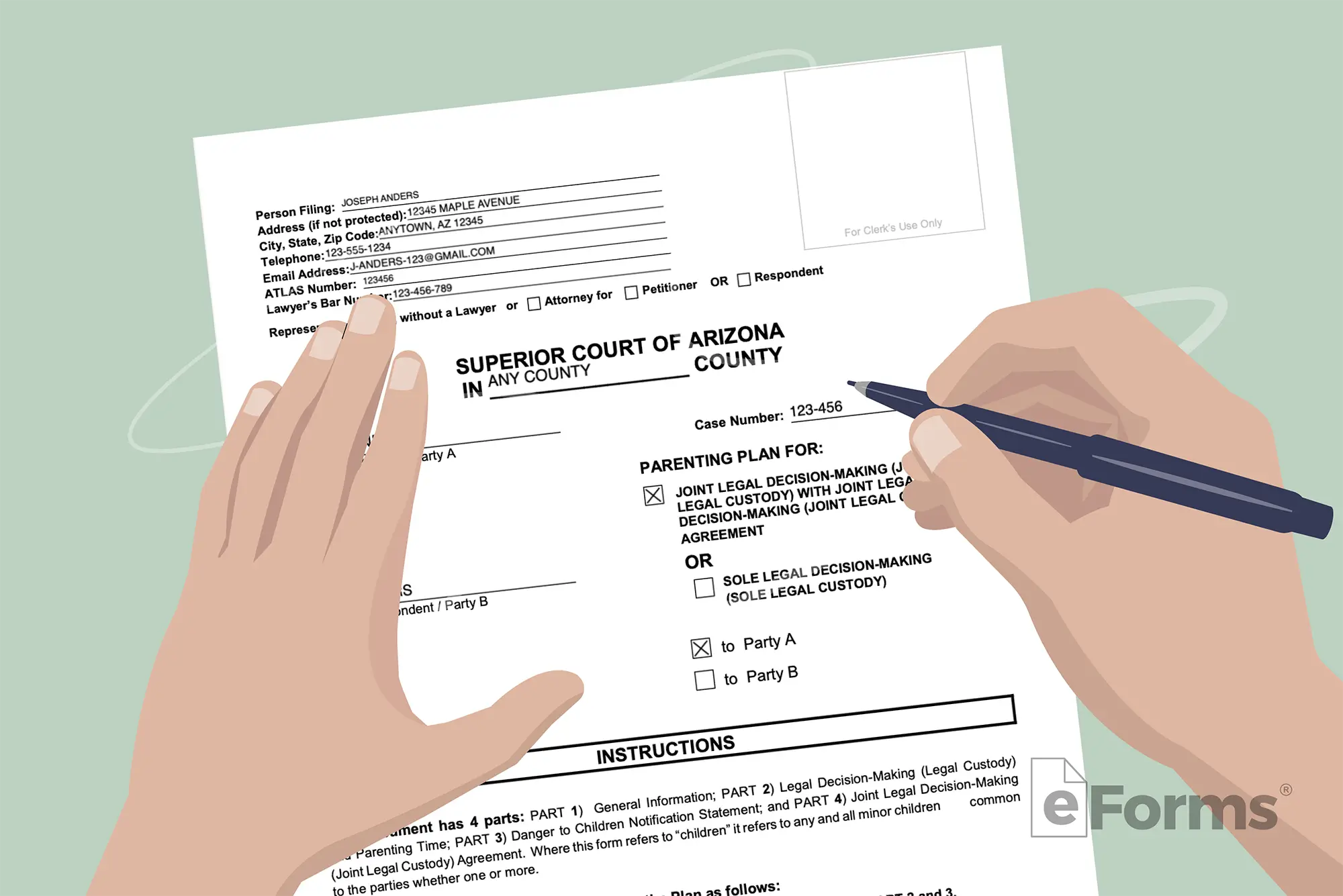
- Parenting Plan (Form DRCVG11f)
- Preliminary Injunction (Form DR14f)
- Sensitive Data Sheet with Children (Form DRSDS10f)
- Petition to Establish Child Support (Form DRES11f)
- Affidavit Regarding Minor Children (Form DRCVG13f)
- Order and Notice to Attend Parent Information Program Class (Form DR12F)
- Summons (Form DR11f)
Additionally, for Married or Separating Parents:
- Petition for Dissolution of a Non-Covenant Marriage (Divorce) with Minor Children (Form DRDC15f) or Petition for Legal Separation with Minor Children (Form DRLSC10f)
- Notice of Right to Convert Health Insurance (Form DRD16f)
- Notice Regarding Creditors (Form DR16f)
- Affidavit Regarding Children (Form DRCVG13f)
- Child Support Worksheet (Form DRS12f)
Additionally, for Unmarried Parents:
- Request for Title IV-D Child Support Services (Form CSE-0167A FORFF)
- Child Support Order When Establishing Paternity (Form DRPS81f)
- Child Support Order (Form DRS81f)
4. File at the Court
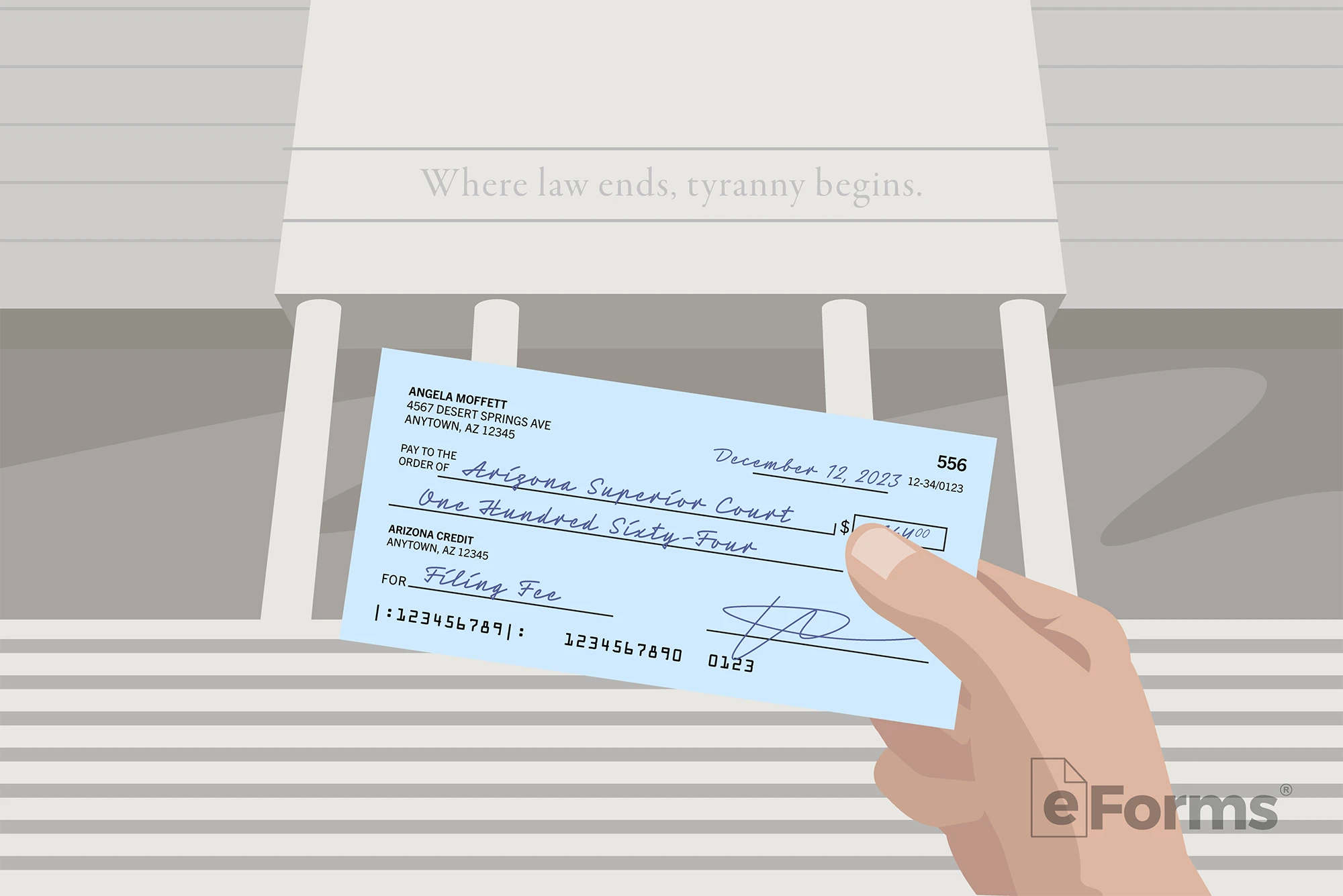
The forms in Step 1 should be filed at the Superior Court Location in the county where the child resides. Make two copies, one for each parent, with the original to be filed with the court (3 total).
The filing fee is $164 to process the petition with the court.[4] However, it is recommended to bring a blank check in the chance of other fees, such as to serve the other parent the papers filed.
If you cannot afford the filing fee, the plaintiff can use the Application for Deferral or Waiver of Court Fees (Form GNF11f). This only allows the fee to be delayed until the court can confirm that the plaintiff cannot afford the fee.
5. Serve the Documents
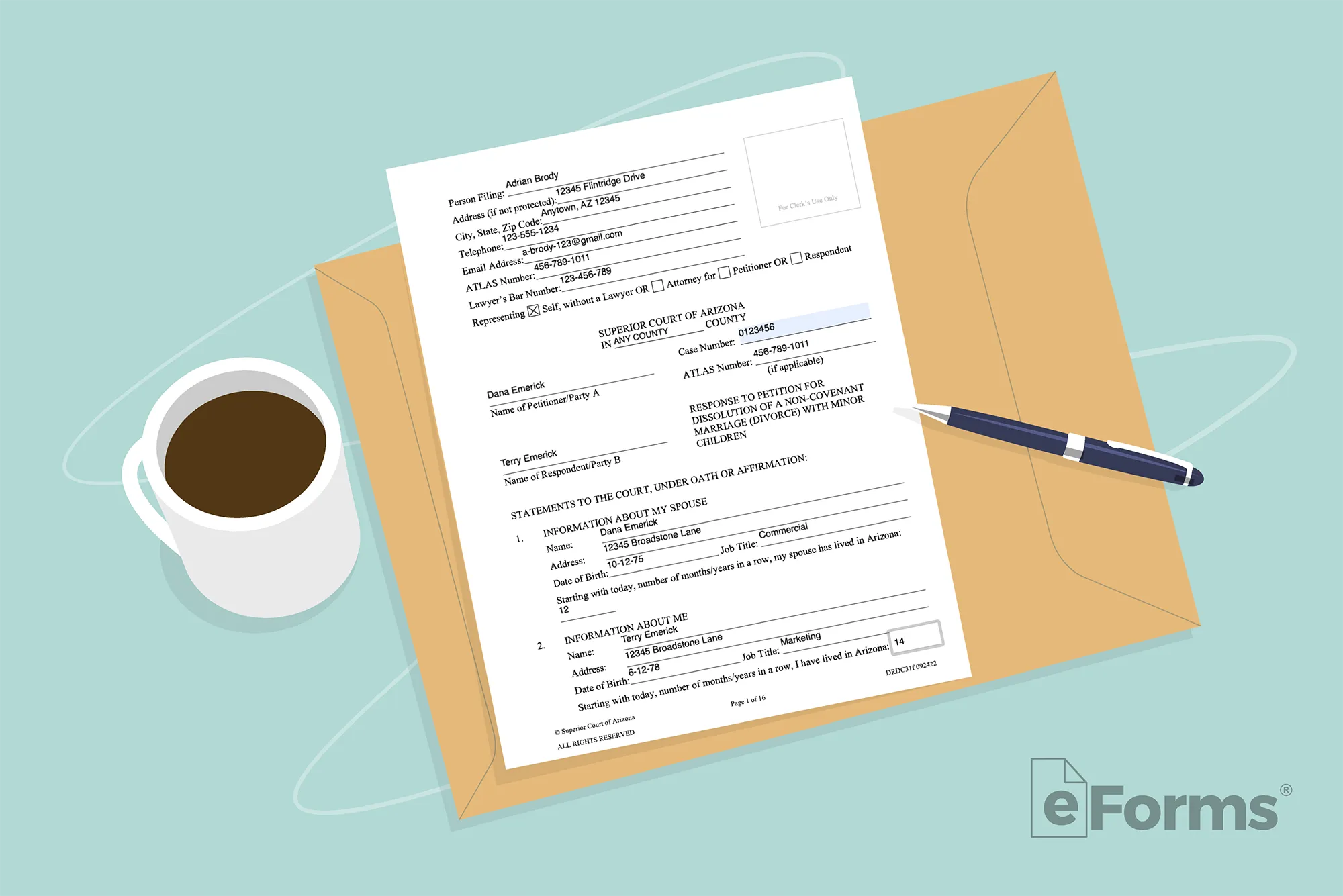
It is required that the plaintiff send an official copy of the papers filed at the court to the other parent. In addition, a “Response” form must be attached. This allows the defendant to provide an official statement to the court.
Include one of the following, depending on the type of court case, when sending to the defendant:
- Unmarried Parents – Form DRP31f
- Legal Separation – Form DRLSC31f
- For a Divorce – Form DRDC31f
There are five (5) ways to serve a parent:
- Certified Mail (recommended) – From the USPS, gives a green receipt upon delivery to the other party that proves they received the papers.[5] This can be used in court if the defendant does not respond to the filing made against them. The petitioner must complete the Affidavit of Service by Certified Mail (Form CVNC24f).
- Acceptance of Service – If both parents cooperate, the petitioner can personally deliver the papers to the other parent and include the Family Dept. Acceptance of Service (Form DR22f).
- Service by Process Server – Use a 3rd party process server to hand-deliver the court forms to the defendant. The process server must complete the Affidavit of Service with Signature Confirmation (Form DR24f).
- County Sheriff – Use an Arizona Sheriff’s Office to deliver the papers to the other parent. After delivering, the plaintiff will receive a Sheriff’s Affidavit of Service (Form PB23p – SAMPLE), which can be used to prove service.
- Newspaper Publication – If the other parent is nowhere to be found, the notice can be made by filing in the local newspaper. The plaintiff is responsible for paying the fee required by the newspaper and must publish the notice at least once for four weeks. Once complete, the plaintiff must file the Letter to Newspaper (Form CVC25p).
6. Wait for a Response
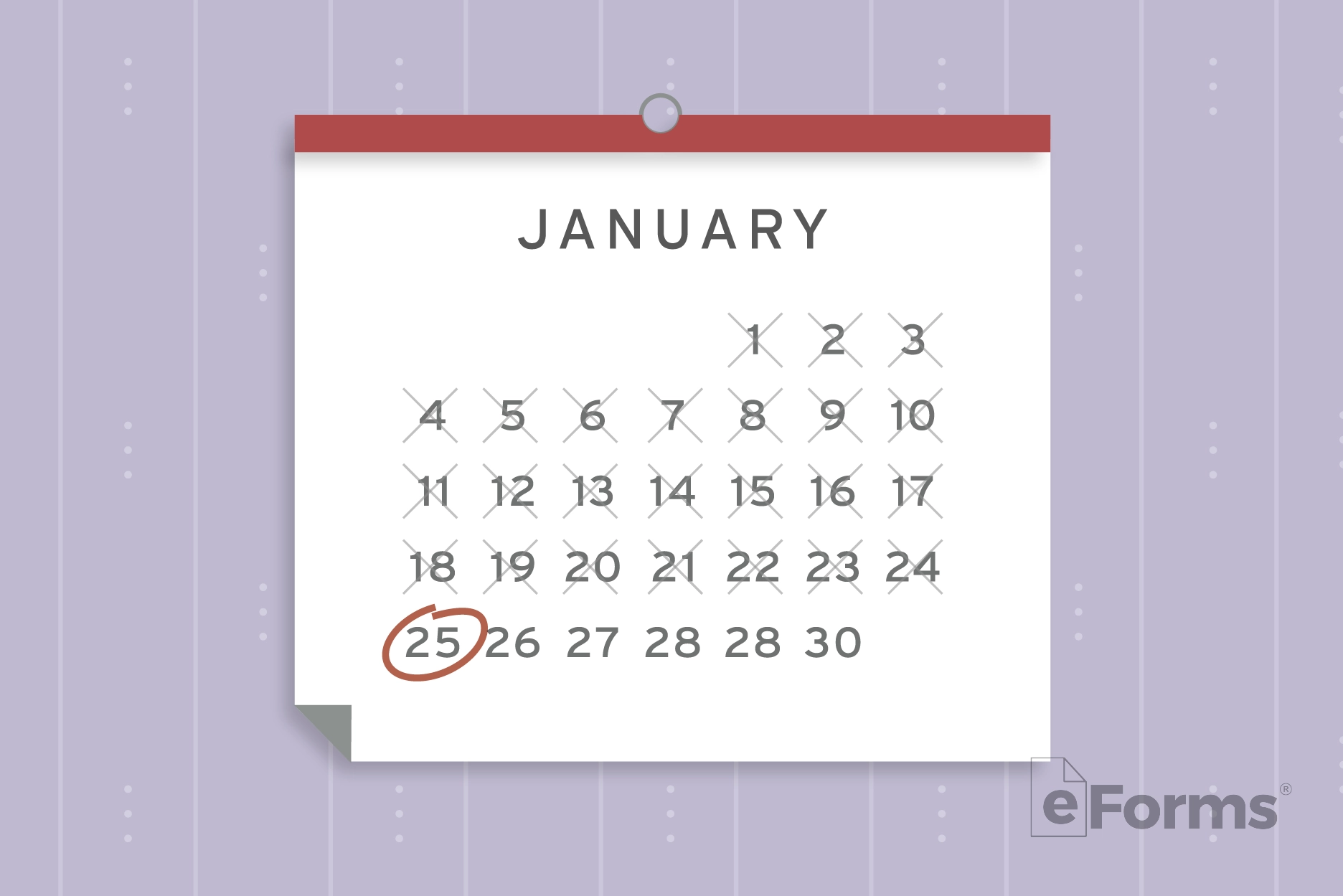
The other parent has 25 days, if certified mail was sent, and 20 days for all other methods to respond to the case brought against them.
If both parents agree, a judgment, without a court hearing, may be possible. This depends on the county and specific court procedures.
If a court hearing is scheduled, both parents will be notified of its date and must attend.
7. Take a Parenting Education Class

Each county is required to implement an educational program on the impact of divorce or separation of unmarried parents.[6] It can be completed online or in a physical classroom.
The program consists of a minimum of 2 hours and a maximum of 6 hours (depending on the county).
It must be completed within 45 days of the forms being originally filed. In most counties, the fee is $50 per person.
8. Obtain a Finalized Judgment

When the court procedures are complete, the judge will produce a finalized consent decree, judgment, or order. This will commonly be given at the final court hearing when both parties have presented their case facts.
Laws
- Main Statute: Title 25, Chapter 8 (Uniform Child Custody Jurisdiction and Enforcement Act)
- Child’s Preference: The court considers the child’s preference if the child is “of suitable age and maturity” (A.R.S. § 25-403)
- Domestic Violence and Child Abuse: § 25-403.03
- Temporary Orders: A.R.S. § 25-404
- Third Party Rights: A.R.S. § 25-409
- Uniform Child Custody Jurisdiction and Enforcement Act: Title 25, Chapter 8
Related Forms

